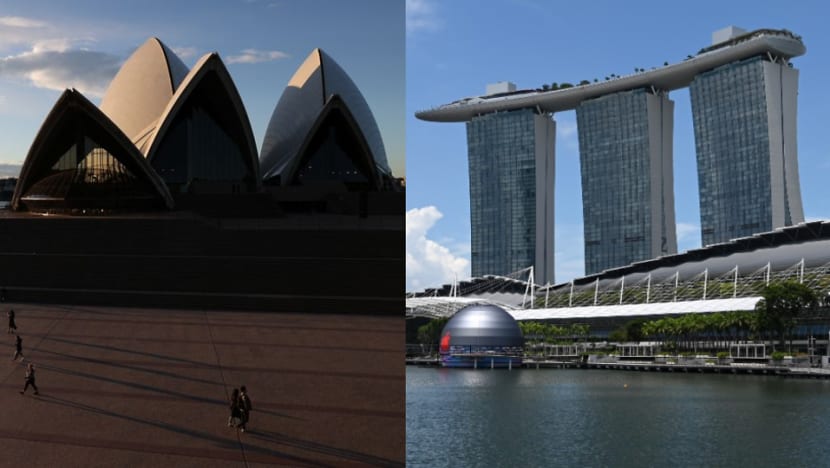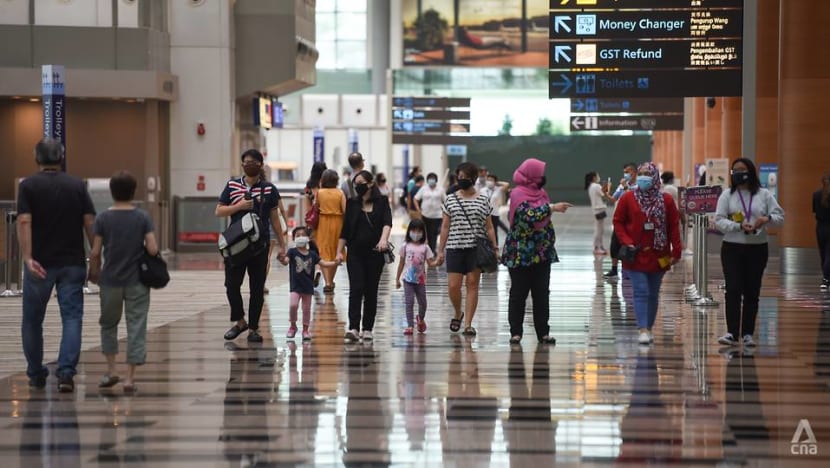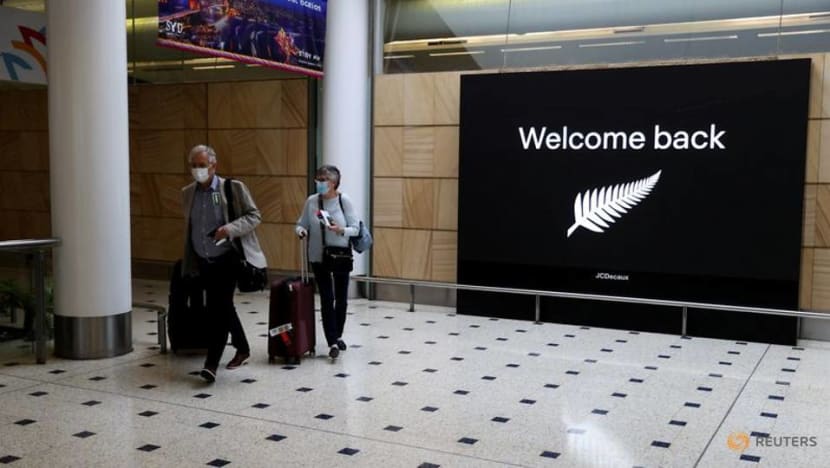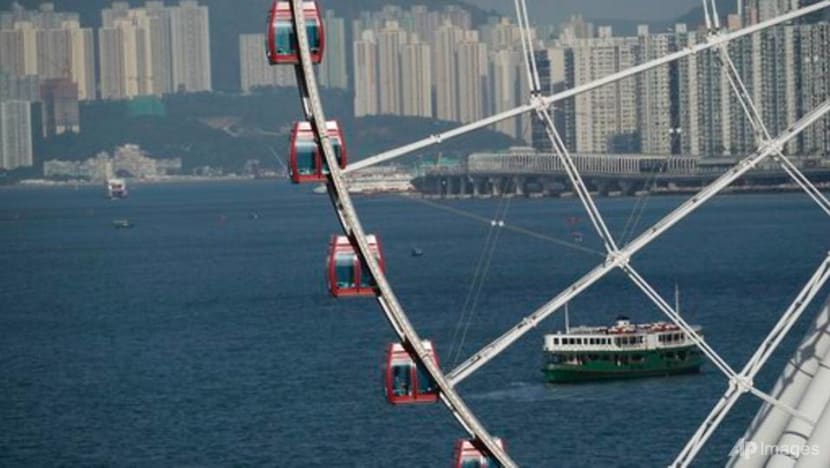commentary Commentary
Commentary: Singapore-Australia air travel bubble is sensible but politically challenging
An air travel bubble between Singapore and Australia may not be imminent, writes Brendan Sobie.

Composite photo of Sydney Opera House (REUTERS/Loren Elliott) and Marina Bay Sands (AFP/Roslan Rahman).
SINGAPORE: The resumption of air travel bubble talks between Singapore and Australia is a welcome development for airlines of both countries and the millions of Singapore and Australia residents who are keen to have their first overseas holidays in more than a year.
A Singapore-Australia bubble is sensible given the success each country has had in controlling COVID-19, their popularity as a tourist destination and the close ties they have historically enjoyed.
A Singapore-Australia bubble was initially proposed several months ago and in theory the two countries could have enjoyed an uninterrupted bubble since November given the low number of cases.
Unfortunately, domestic issues on the Australia side has made this impossible and these will have to be resolved before its federal government can successfully implement a bubble with Singapore or any other country.
READ: Commentary: We must save Singapore Airlines from this existential crisis
EXTREMELY CONSERVATIVE COVID-19 ELIMINATION STRATEGIES
Australia’s states have extremely conservative COVID-19 elimination strategies which has made it very difficult to keep internal borders open.
States have closed internal borders several times – even if there are only a few local cases or a single case in another state or territory.
In the most recent examples, New South Wales, South Australia and Western Australia closed their borders with Victoria in February and South Australia, Queensland and Victoria shut their borders with New South Wales in January.
READ: Commentary: Our flights of fancy have stopped but were they all that romantic anyway?
In 2020, internal borders saw numerous closings. There was only a very brief period in December that all of Australia’s internal borders were open.
While all internal borders are now open again, enabling Australia to promote domestic tourism, there is still a risk they will close once again, making any international reopening difficult to pursue.
EVEN A SINGLE CASE CAN LEAD TO SNAP LOCKDOWNS
Until Australia adopts a COVID-19 containment strategy similar to Singapore it will be hard to implement and maintain any air travel bubble.

Singapore’s containment strategy enables its economy to stay open under Phase 3, which includes only limited restrictions, and permits air travel bubbles if there is a small number of unlinked cases.
In Australia even a single case can result in snap lockdowns – such as what happened in Perth at the end of January and early February.
Very small number of local cases also have led to snap lockdowns in recent months in Adelaide, Brisbane, Melbourne and parts of Sydney.
While Australia’s federal government is now keen to keep internal borders open and start reopening internationally, starting potentially with Singapore and New Zealand, this could prove moot given how state governments have so far dictated their own strategies.
A trans-Tasman bubble between Australia and New Zealand was initially discussed nearly a year ago with a proposed implementation date of June 2020 but has been set back repeatedly by domestic issues in both countries.
READ: Commentary: How did Melbourne become the centre of the ‘world’s strictest lockdown’?
New Zealand also has a strict COVID-19 elimination strategy, prompting multiple snap lockdowns, including a lockdown following a single case that ended on Mar 7.
Australia and New Zealand have been planning for several months to establish a bubble with each other – and potentially with some South Pacific islands – before considering bubbles with any Asian country.
ENTICING NEW ZEALAND TO IMPLEMENT A TRANS-TASMAN BUBBLE
Australia’s latest round of bubble talks with Singapore initially seemed to indicate that it was ready to put aside the idea of a trans-Tasman bubble and move forward with Asian countries. But it could also be interpreted as a tactic to entice New Zealand to finally implement the trans-Tasman bubble.
It now seems this tactic has succeeded as on Mar 18 New Zealand indicated that it is ready to move forward with the trans-Tasman bubble as early as April.
Australia opened up to New Zealand on a unilateral basis in October 2020, creating what it calls a one-way bubble.
Singapore earlier opened to New Zealand on a unilateral basis, in August 2020, and also opened to Australia on a unilateral basis in October 2020.

While these one-way schemes have been temporarily closed at times due to local cases, at the moment they are again in effect, enabling passengers arriving in Singapore from Australia or New Zealand and arriving in Australia from New Zealand to avoid quarantine.
However, New Zealand has still not reciprocated with Singapore – and is not about to anytime soon given its very conservative COVID-19 elimination strategy.
It is easier for New Zealand to work with Australia as both have COVID-19 elimination strategies but a New Zealand-Australia bubble could make it harder for Australia to implement a bubble with Singapore.
Australia is also unlikely to reciprocate and match Singapore’s unilateral opening as this would result in a completely open market with an unlimited number of flights.
READ: Commentary: Hong Kong and Singapore air travel bubble could be a game-changer
A QUARANTINE HUB?
Air travel bubbles have restrictions on the number of flights and Australia may require that passengers are vaccinated, providing an extra level of safety to supplement the typical COVID testing requirement.
A Singapore-Australia bubble could also include Singapore becoming a vaccination or quarantine hub for passengers heading to Australia from other countries, particularly Australian citizens who have been stranded overseas, but this is not necessary and is unlikely to be approved.
The idea of Singapore becoming a quarantine hub for repatriating Australians initially emerged several months ago – long before any vaccine was approved – under an industry led proposal that was quashed by government stakeholders.
The vaccine hub concept is newer but also very challenging, particularly given the sticky issue of governments making vaccines available to non-residents.
While there are numerous uncertainties that could derail a Singapore-Australia bubble, if it does happen it could have a significant impact on the aviation and tourism sectors in both countries.
READ: Commentary: Moving to Singapore in the middle of a pandemic has changed the meaning of home
POTENTIAL TO BE A MUCH BIGGER TRAVEL BUBBLE
Singapore is the second largest market for Australia after New Zealand, generating 6.4 million passengers on non-stop flights between the two countries in 2019, based on data from Australia’s Bureau of Infrastructure, Transport and Regional Economics (BITRE).
This equates to 15 per cent of total international passenger traffic in Australia and 9 percent of Singapore’s total traffic.
Prior to the pandemic, Singapore Airlines (SIA) Group served eight Australian cities with up to 25 daily flights.

The SIA Group, including budget subsidiary Scoot and regional subsidiary SilkAir, flew 4.37 passengers between Australia and Singapore in 2019, including passengers that connected in Singapore to other flights.
The Qantas Group, which includes budget subsidiary Jetstar, served Singapore prior to the pandemic from five cities in Australia with up to eight daily flights.
The Qantas Group carried 1.71 million passengers between the two countries in 2019, excluding passengers continuing beyond Singapore on its one-stop Sydney-London A380 service.
British Airways and Emirates also compete in the Australia-Singapore market with British Airways operating one daily flight and carrying 73,000 passengers in 2019 and with Emirates operating two daily flights and carrying 204,000 passengers – excluding passengers continuing beyond Singapore to London or Dubai.
Local traffic between Australia and Singapore consisted of over 3 million passengers in 2019 – it is this segment of the market an air travel bubble targets as transit passengers have to be flown on separate flights.
READ: Commentary: To facilitate regional air travel again, ASEAN needs to harmonise standards
In 2019, Singapore reported 1.14 million visitor arrivals from Australia, including 1.03 million which arrived at Changi, while Australia reported 479,000 visitor arrivals from Singapore.
There is also a large Australian expat community in Singapore and a large Singaporean community in Australia, including students that fly between the two countries and would not be counted in the visitor numbers.
In the Singapore-Hong Kong market, as I wrote in a previous commentary, there were about 2 million annual local passengers prior to the pandemic.
SEVERAL CHALLENGES ON THE HORIZON
A Singapore-Australia bubble therefore has the potential to be much bigger than the Singapore-Hong Kong bubble.

However, this will depend on how many flights are ultimately permitted.
With the Singapore-Hong Kong bubble only two daily flights were initially permitted – one each for Cathay Pacific and SIA – resulting in a relatively insignificant impact on traffic.
While a Singapore-Australia bubble should be larger given that Australia is a big country with several cities to be included, the bubble would still likely start with a relatively small number of flights.
A Singapore-Australia bubble could expand over time but there is also a risk it could contract or be suspended if there is a rise in COVID-19 case numbers, similar to what has occurred with the Singapore-Hong Kong bubble since its start was indefinitely postponed in November 2020.
SIGN UP: For CNA’s Commentary weekly newsletter to explore issues beyond the headlines
It is also likely the Singapore-Australia bubble could take several months to implement – assuming it does happen – given the domestic challenges in Australia that I highlighted earlier.
Singapore is currently considering air travel bubble proposals with several countries and Australia is unlikely to be the first given the time it will take for Australia to resolve its internal issues.
The third quarter would be the earliest possible implementation date for Singapore-Australia while other bubbles could still happen in the second quarter.
Listen to the author also dissect the future facing national flag carriers after the pandemic and the role of Singapore Airlines on CNA's Heart of the Matter published in September 2020:
Brendan Sobie is the founder of Singapore-based independent aviation consulting and analysis firm Sobie Aviation. He was previously chief analyst for CAPA - Centre for Aviation.















